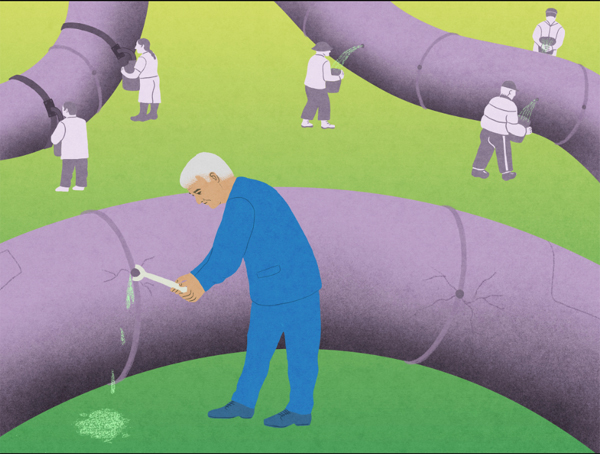
Amy Stilman, bloomberg News
MEXICO CITY
EnergiesNet.com 07 08 2022
Four months into his presidency, Andrés Manuel López Obrador walked up to a podium at Mexico’s national palace and declared victory against the hordes of thieves that had been siphoning millions of gallons of gasoline a day from government-run pipelines for years.
“We have managed to practically eliminate fuel theft,” the president, known as AMLO, proclaimed three years ago. He turned around to face a chart projected behind him and began rattling off some self-affirming numbers. Under his watch, he said, fuel theft had fallen 94%. Stolen gallons had dropped from 3.4 million a day in November 2018—the month before AMLO took office—to roughly 200,000 in April 2019, saving the state-owned oil company Petroleos Mexicanos, or Pemex, billions of dollars.
“This is proof,” he said, “that corruption is not tolerated.”

AMLO won his presidency on a promise that he’d eradicate the graft and greed that have plagued Mexico for decades. At the centerpiece of his fight was putting an end to the rampant pillaging of Pemex fuel. He took extreme measures, among them closing hundreds of miles of Pemex’s pipelines to discourage theft, which created nationwide gasoline shortages in January 2019. He reopened them only after sending in the National Guard and recruiting military surveillance—an effort that remains in effect today. He ordered investigations into gasoline stations suspected of accounting irregularities and shut retailers that failed to meet regulatory requirements.
On the surface, Mexico’s decline in gasoline thefts looks like AMLO’s single largest victory yet in his fight against crime. But a visit to the streets of a crime-ridden cluster of municipalities in central Mexico known as the Red Triangle shows the limits of AMLO’s reach.
On a quiet street in Tecamachalco, Puebla, a fuel thief who goes by El Gordo—a heavyset man wearing ripped jeans and a T-shirt soaked in sweat—smiles as he calculates the day’s earnings on his cellphone. El Gordo used to make good money stealing and reselling gasoline. But when Pemex cut off gasoline flows to the Red Triangle, he began stealing liquefied petroleum gas—the lifeblood of Mexico’s food vendors and the heating source for the majority of the nation’s homes.
It wasn’t difficult. While federal troops are standing guard at gasoline and diesel pipelines, Mexico’s 1,600 kilometers (1,000 miles) of LPG pipes have gone largely unwatched. The scheme starts with a bribe; a Pemex worker is paid to tip off thieves like El Gordo when LPG is running through a line and tells them where to open the valves. Then comes the dangerous part—siphoning the gas, which unlike gasoline can’t just be poured into a bucket. They must carefully connect a hose to the pipe to funnel the LPG into cylinders. Because of the explosive nature of the fuel, thieves typically offer home delivery.
Although gasoline thefts are down in Mexico compared with four years ago, these illegal LPG taps have surged more than 1,000% between 2018 and 2021. The number of taps Pemex discovered totaled 2,402 last year, up from 215 in 2018, according to company data compiled by Mexico’s LPG associations. It’s still a smaller market than the one for illegal gasoline ever was, but it’s growing—exponentially. Pemex is now losing about $1 billion a year from LPG thefts, roughly a third of what it was losing from stolen gasoline before AMLO declared war on fuel thieves, according to the trade groups.
Bloomberg Businessweek visited five municipalities in the central states of Puebla and Hidalgo that were most notorious for gasoline theft to document the effects of AMLO’s crackdown. People there tell two familiar tales: one of the poverty and oppression that drive mostly young men into a life of theft; another of the death and violence that have spread across the region since AMLO’s war against the so-called huachicol shrank the illegal fuel market and consolidated power into the hands of a few large-scale, cartel-driven operatives now engaged in bloody turf wars. This is what happens, they say, when you treat the symptom and not the disease.
AMLO’s efforts were “a good advance, and we must acknowledge that,” says Carlos Serrano, director of a Mexican LPG trade group known as Amexgas. “Nevertheless, in LPG, the opposite has happened.”
AMLO acknowledged early on in his campaign that a leading cause of gasoline theft is poverty, which he promised to combat with 3.86 billion pesos ($188 million) in social programs. He doubled down on his commitments after a gasoline pipeline that thieves tapped exploded in Tlahuelilpan, Hidalgo, in January 2019, killing 137 people. “We are going to provide options, alternatives, so that people have a legal way, an honest way, of obtaining their income, of satisfying their needs,” he said at the time.
Since then, Mexico’s Ministry of Welfare said in a statement, AMLO’s administration has provided financial assistance to more than 300 people affected by the tragedy, including scholarships, child care support, and coverage for funeral and legal expenses. And more than 80 billion pesos have been invested in construction projects, creating jobs and improving infrastructure in the area, the ministry says.
None of this has proven enough to stop El Gordo and others like him. For a while he tried to make an honest living to support his wife and children by starting his own carpentry business, but he struggled to make ends meet. In 2014 some gasoline thieves asked him to join their ranks. They told him he could make more money stealing fuel than he could ever make as a carpenter, and they were right. On a good day, he sells as many as 80 cylinders of stolen LPG for about 350 pesos to 400 pesos, about 20% to 30% below the market rate, and pockets half the revenue. That puts his profits at 40 times higher than the average salary in Tecamachalco and almost 70 times higher than the minimum wage across Mexico, where more than 40% of citizens live below the poverty line.
He’s used the windfall to buy nice clothes, expensive jewelry, and presents for his family. “I’ve bought several plots of land with the profits from LPG sales,’’ says El Gordo, asking not to be identified out of fear of being targeted by government officials. “I can take more vacations with my family.” He’s also suffered the consequences. Lifting his shirt, he points to two bullet wounds in his stomach. Getting shot, he says, is an occupational hazard. He’s watched colleagues lose their lives to the trade—now more so than ever.
“The disappearance of people is increasing considerably,” says one firefighter in Tecamachalco, who asks not to be identified out of fear of retaliation. “In a month, we discover about two or three bodies. But there are many more if you consider that other fire departments find the same number.” He attributes the rise in killings to intensifying turf wars among fuel theft rings that dump the bodies of victims in pozos—deep, dry holes previously used to store water on farms.
A spokesman for AMLO didn’t respond to requests for comment about the rise in violence across the region. In the state of Hidalgo, homicides have increased by 24% in the first five months of the year, to 124. In Puebla, they’re up 26%, to 398. Huachicoleros have attacked Pemex security guards, burned patrol cars, and lynched agents from the attorney general’s office. In Puebla, criminal groups that engage in gasoline and LPG theft also tend to be involved in kidnappings, drug peddling, and car burglaries, according to local police.
Complicated relationships have formed between the huachicoleros and the communities in which they operate. The locals have come to depend on—and in some cases celebrate—them for the affordable fuel they sell. But they also despise and blame them for the increasing violence on their streets.
In the state of Hidalgo, one bar has a cocktail named after the huachicoleros that’s served in a miniature gasoline jerrycan. The thieves there sell gasoline at half the retail price, offering some relief from rampant inflation and soaring energy costs. They also fill the void left by a government welfare system that often falls short.
Driving through the cobblestone streets of San Bartolo Tutotepec in Hidalgo, a man who goes by Chapa recalls a past life when he ran with a group of guys who tapped Pemex pipelines in the middle of the night for gasoline. He’s in the business of selling pottery now, but he talks about the local thieves with fondness. When Chapa’s wife was hospitalized for several months in 2019, it was Hidalgo’s resident fuel thieves that gave him the free gasoline he needed to visit her.
Residents interviewed by Businessweek in Puebla and Hidalgo say they’ve seen none of the aid promised by the government and weren’t aware of social programs available to them. Fuel thefts remain commonplace in both areas. At a military outpost in Hidalgo, a soldier stands around idly, kicking up dust with his boots. He’d been sent to guard the Tula-Salamanca gasoline pipeline against illegal taps, and yet two had been reported just that morning. As much as AMLO would like every inch of the system under surveillance, the military doesn’t have the resources to watch an entire 223-kilometer line, particularly in the places where it crosses rugged terrain that cars can’t reach, he says.
In Puebla, the military is so focused on gasoline and diesel pipelines that LPG networks have turned into a free-for-all, says Luis Landeros, president of the Association of Liquefied Petroleum Gas Distributors. “Organized crime went to LPG,” he says. “We have an estimation that between 15% and 20% of the market in the center of the country is inundated with this illegal product.”
AMLO is starting to acknowledge that fuel theft remains a problem in Mexico. In several press conferences in May, he noted that gasoline taps were up from a year earlier. He even made reference to LPG theft.
The thieves ”are wrong if they think they can act with impunity,’’ he said during one of these conferences. “In the government that I lead, and its like this in Puebla, there is no impunity, zero impunity.”
—With Rafael Gayol
bloomberg.07 08 2022












